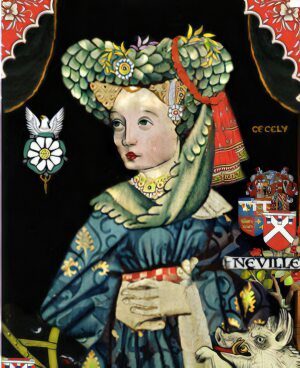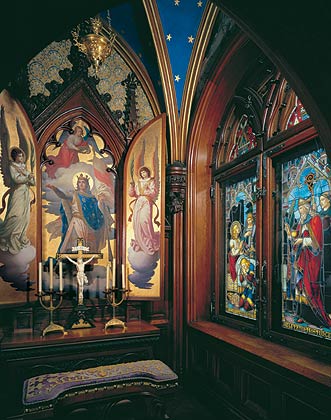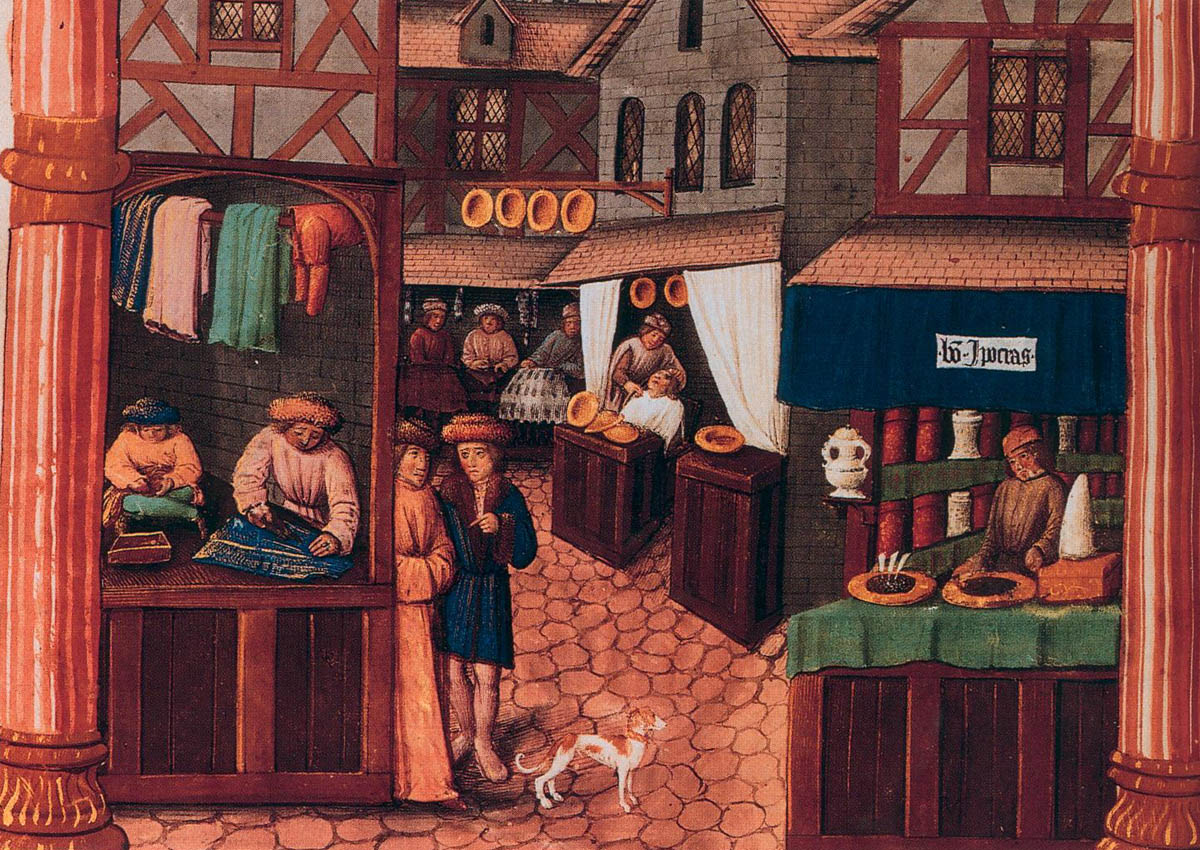The 80 years of Cecily Neville's life would see her family's power rise, fall and rise again as she became wife of a pretender to the English throne, mother to the two Yorkist kings, and grandmother to the first Tudor queen. Cecily, however, would tragically outlive her husband and all of their 13 children.
'ROSE OF RABY'
Cecily Neville was born on 3 May 1415 at Raby Castle in Durham as youngest daughter to parents Ralph Neville, 1st Earl of Westmorland, and Joan Beaufort with Cecily's good looks rewarded with the sobriquet 'Rose of Raby'. Her maternal grandparents were the English prince, John of Gaunt, 1st Duke of Lancaster, and Katherine Swynford. The family connections to the Beauforts would see Margaret Beaufort, mother of Henry Tudor, as Cecily's second cousin.
Ralph Neville had become the royal warden of Richard, Duke of York after York's father, Richard of Conisburgh, was condemned to death in 1415, and the young duke arrived at Raby Castle in December 1423 to live with the Nevilles. Cicely's father betrothed her to York in October 1424 at the expense of 3,000 marks to the crown to release York from his wardship. Cicely was 14 years-old and York was 18 when the couple married in October 1429 and would remain married for 31 years with Cicely bearing 13 children, seven of whom survived childhood.
 |
| Fotheringhay Castle in Northamptonshire was a favourite family residence |
York's vast estates would see Cecily live in Ludlow Castle in Shropshire, Fotheringhay Castle in Northamptonshire and Baynard's Castle in London. The contented marriage saw Cicely follow her husband to France and Ireland during York's time in office. Rouen in France would see the births of Cecily's eldest living sons Edward and Edmund and second living daughter, Elizabeth, between 1443 and 1444.The third living son, George, was born in 1449 in Dublin, Ireland and Cicely would bear children across 17 years and daughters Anne, Margaret and youngest son Richard were all born at Fotheringhay Castle. This would indicate that Fotheringhay Castle was the family's favourite residence.
Cicely was renowned for her piety, attending eight services a day, and this would make a mockery of later Lancastrian propaganda that slandered her as an adulteress with the rumour that Edward IV was born a bastard to Blaybourne, a French archer. The Duchess would vehemently protest against this slander and Cicely's own pride and temper would bring her the nickname 'Proud Cis'.
LADY PROTECTOR
The Duke and Duchess of York attended the wedding of King Henry VI and Margaret of Anjou in May 1445 and the queen would show court nepotism at Duke of York's expense. Cecily's first cousin, Edmund Beaufort, 2nd Duke of Somerset, replaced York as Lieutenant of France but wasn't able to emulate York's time in office as France reclaimed Normandy along the English Channel coast.
Southern England was fearful of a French invasion and Jack Cade led an unsuccessful rebellion against the king and his "friends". Cade appealed to York supporters by calling himself Mortimer after York's ancestors and demanded that Henry VI removed his friends or the king would be replaced by York if this wasn't done.
York had no association with Cade but the rebellion caused many at court to ponder whether York was going to claim the throne when he travelled from Ireland to England in September 1450. York protested his allegiance to the king and demanded Somerset's arrest over France. Henry VI initially agreed but the queen intervened and duly promoted her court favourite to Captain of Calais. York was in turn given a much the lower ranked title of Justice of the Forest South of the Trent.
 |
| Cecily's nephew, Earl of Warwick, originally supported his Beaufort relatives |
A frustrated York returned to his estates. Cecily, pregnant with Richard, may have encouraged York to reassert his power and birthright which led to her husband gathering troops and marching on London but he would find the capital gates locked. York reached Dartford in Kent and faced off against the royal troops including Cecily's brother, Richard Neville, Earl of Salisbury and his son, Richard Neville, Earl of Warwick. York looked for peace and demanded Somerset's arrest but the queen intervened once again.
Margaret of Anjou was incensed to see Somerset being carried away in chains and a showdown in the royal tent saw Queen Margaret demand York's arrest instead. The Duke returned to London being paraded like a prisoner at the head of the royal party.
Cecily came to her husband's defence and the queen agreed to hear the Duchess' pleas for clemency at the shrine of Our Lady of Walsingham in Norfolk. The Duchess would later write to the queen and praised the meeting where Cecily surmised that her husband's "infinite sorrow and unrest of heart" caused him to be "estranged from the grace and benevolent favour" of the king. Cecily's plan worked as the queen stopped pursuing York's imprisonment but York he was publicly humiliated at St. Paul's Cathedral where he swore an oath of allegiance to the king.
York was mindful of his own father's fate and withdrew to his estates once again to spend time with the family. York also provided much needed support to his in-laws in their land disputes with Somerset and Neville's northern rivals, the Percies.
The royal couple welcomed their long-awaited heir in 1453 when the queen gave birth to Prince Edward. Henry VI was unable to acknowledge his son's existence after the king descended into a severe bout of mental illness following England's heavy loss at the Battle of Castillon. England needed a leader as York returning to court and was elected Lord Protector in March 1454. York brought much needed order and appointed his brother-in-law, Salisbury, as Chancellor and his nephew, Warwick, became Captain of Calais.
York's control of government didn't last long as Henry VI regained his senses during Christmas 1454 and Somerset, imprisoned in the Tower by York, was released. Parliament was to reconvene in Leicester in May 1455 and York saw this as a ruse by the queen to arrest him. Cecily's brother and nephew joined her husband and intercepted the royal army at the First Battle of St. Albans where Somerset was killed and the king captured.
 |
| Cecily's brother successfully fought off a Lancastrian charge at Blore Heath |
York would return as Lord Protector after Henry VI relapsed towards the end of 1455 and a rejuvenated king kept Warwick on as Captain of Calais after Henry VI recovered in 1456. The queen would now target Cecily's nephew with charges of piracy and a suspected murder plot against Warwick, further antagonising the Yorkist and Lancastrian divide. York and the Nevilles gathered troops and met at Ludlow in October 1459 after Salisbury had defeated a portion of the royal army at the Battle of Blore Heath en-route to Shropshire.
DESERTED
Henry VI led his troops to just south of Ludlow and offers of royal pardons proved too tempting to York's army as Warwick's Calais troops commanded by Andrew Trollope, defected. The Battle of Ludford Bridge proved to be bloodless after York abandoned his army and fled the battlefield. York took Edmund, now Earl of Rutland, to Ireland whilst Edward, now Earl of March, joined his uncle and cousin in fleeing to Calais.
 |
| Cecily and her children were captured in Ludlow Market Square |
Cecily was left to defend Ludlow with her three youngest children and they were discovered by the Lancastrian army at Ludlow Market Cross. Cecily pleaded for clemency once again and was placed under the care of her sister Anne, Duchess of Buckingham, and her husband, the Lancastrian commander, Henry Stafford, Duke of Buckingham.
The Duchess of York and her youngest children stayed with the Buckinghams at Tunbridge Castle in Kent and it's close proximity to Calais would have allowed possible secret communications between Cecily and her eldest son. Cecily, like seven years before, defended her husband at court and asked for a royal pardon. She was unsuccessful in preventing her husband, brother and nephew being given an Act of Attainder which forfeited all their lands and titles. The queen, possibly remembering the time at Walsingham, may have taken pity on Cecily and the defunct-Duchess was granted £600 a year to support herself and her children.
 |
| Cecily resided in London at Banyard's Castle before York returned to England |
Cecily's nephew and husband met in Ireland during the spring of 1460 to plan a return to England and Warwick, Salisbury and Edward landed in Sandwich on the Kent coast in June 1460. Salisbury held London and welcomed his sister to the capital as she took up residence in Banyard's Castle following the Yorkist victory at the Battle of Northampton. Warwick and Edward faced the royal troops in July 1460 near Northampton where treachery would allow March to take the vanguard and breach Lancastrian defences. The Lancastrian commanders were taken by surprise once the Yorkists were behind the front-lines and Buckingham would die defending the king who would once again be captured and brought back to London.
QUEEN-IN-WAITING
York returned to England on 8 September 1460 and immediately sent word to Cecily for the married couple to meet at Hereford. Cecily travelled to the west country in a charriot or litter dressed in blue velvet and carried by eight horses. York likely discussed his intentions of claiming the throne with Cicely at Hereford and, wIth Margaret of Anjou fleeing to Scotland, Cecily acted every part of a queen as she carried the royal arms during her husband's procession to London.
 |
| The Duke and Duchess of York reunited in Hereford before proceeding to London |
Her husband's bold move in claiming the throne from Henry VI got little support in Parliament including Warwick and Salisbury who weren't aware of York's plan. A compromise in Parliament was struck in late October 1460 with an Act of Accord declaring York as heir-apparent and disinherited Prince Edward. York and his heirs would now take the throne once Henry VI died and Cecily became a queen-in-waiting.
Word soon spread that Margaret of Anjou was courting Scottish support and the Percies were raiding the Yorkshire estates of York and Salisbury. York sent Edward to the Welsh Marches to rally the troops, Warwick held London and York took Edmund and Salisbury north to face the Lancastrians. Cecily gave her husband and son a fond farewell in early December 1460 and expected to welcome their return in the New Year. This never happened and Cecily was devastated when she heard of the deaths of her husband, second son and eldest brother at the Battle of Wakefield.
































.jpg/220px-King_Henry_VI_from_NPG_(2).jpg)